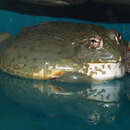Description
provided by AmphibiaWeb articles
Giant bullfrogs are the largest amphibians found in southern Africa. In Gauteng males reach a snout-vent length of 245 mm and a mass of 1.4 kg. In contrast to most other frogs and toads, males are larger than the females. The head is very broad. Two large bony spines separated by a smaller spine project upwards from the lower jaw. Several prominent, interrupted skin ridges are present on the back. A spade-like inner metatarsal tubercle is present on each heel, and is used for digging (Minter et al. 2004). In adults, the dorsum is dark olive-green, but may vary from brown to grey and even blue; short sections of the longitudinal skin ridges may be white or cream. In juveniles, a pale vertebral stripe is often present, contrasting sharply with the bright green ground colour. The abdomen is white to creamy-yellow, except in the region of the forelimbs, where it is bright yellow in breeding males. Dark mottling may be present in the gular region of males (Du Preez 1996)
Du Preez, L.H. (1996). Field guide and key to the frogs and toads of the Free State. University of the Orange Free State, Bloemfontein, South Africa.
Distribution and Habitat
provided by AmphibiaWeb articles
Terra typica: „Promontorium Bonae Spei“ (= Cape of Good Hope, Rep. South Africa) Nigeria to Somalia, Kenya, Tanzania, Mozambique, Malawi, Zambia, Zimbabwe, Angola, abd Rep. South Africa, excluding of the southwestern Cape Province. Found in drier savannas in large pans that fill with water during rains.
Life History, Abundance, Activity, and Special Behaviors
provided by AmphibiaWeb articles
Male calls from shallow water. Breeding starts after heavy rain initiated by 65 mm of rain over the previous day or two. Breeding during day time, spawning from 7.00 to 16.00. Males have two breeding startegies, depending on their age. Younger males congregate in a small area, perhaps only 1 or 2 square meters of shallow water. The larger males occupy the center of these breeding arenas or leks and attempt to chase off other males. A female approaches the group of males by swimming along at the surface until she is within a few meters of the group. Female dives and reappears on the surface in the middle of the group. She is soon grasped by one of the larger males, and mating ensures. Eggs are laid in the shallow edge of the pond, but fertilization takes place above water level. Eggs are fertilized before they reach the water. Full grown males are more agressive. They fight, causing injury and even killing one another. The dominant male attempt to prevent other males from participating in breeding. Most of the females are mated by the dominant male in his territory. The dominant male takes care of the tadpoles. Egg laying occurs in a small area, and the tadpoles hatch together. P. adspersus will eat just about anything, and are sometimes cannibalistic. During the dry season the frogs live underground. P. adspersus can reach an age of 45 years. Predators of the adults are birds and of tadpoles include turtles (Pelusios) and monitors (Varanus niloticus).

